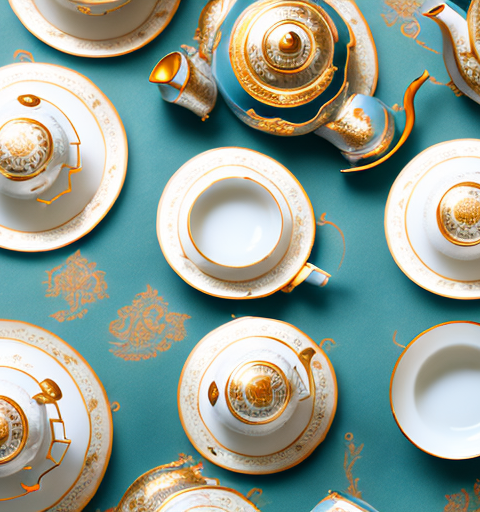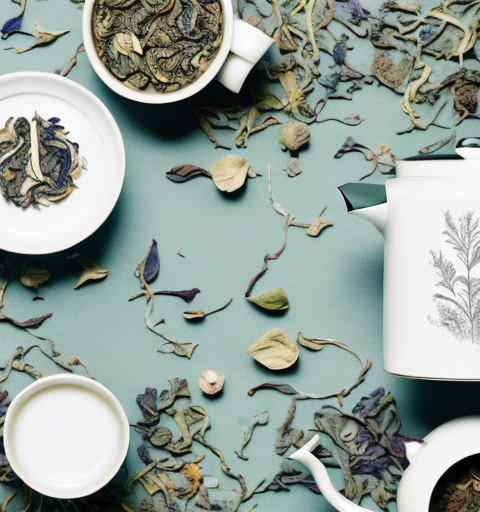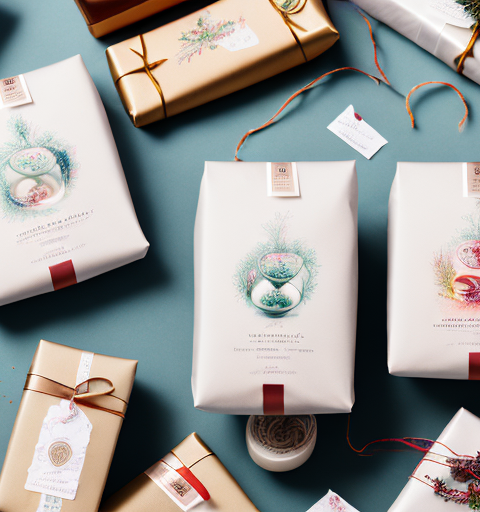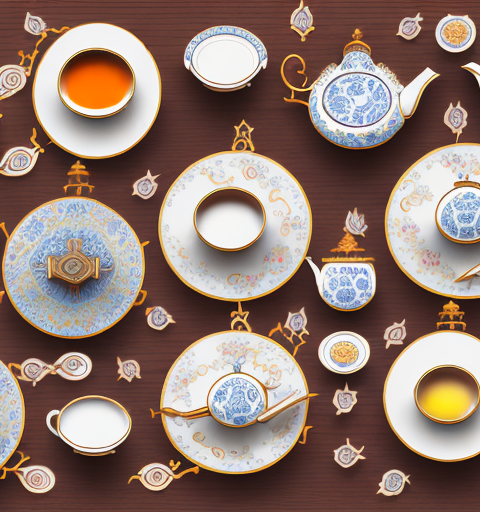If you are a fan of white tea and own a ceramic teapot, you may be wondering whether you can use it for brewing your favorite tea. In this article, we will delve into the topic in exhaustive detail to help you understand the process better and make an informed decision.
Understanding the Different Types of Teapots
Before we delve into whether a ceramic teapot is suitable for brewing white tea, let’s take a moment to explore the different types of teapots available. Teapots come in various materials, including ceramic, glass, porcelain, cast iron, and more. Each material has its own unique properties and advantages, which can affect the flavor and brewing process of the tea. Ceramic teapots are widely popular due to their versatility, aesthetic appeal, and ability to retain heat efficiently. They are especially well-suited for brewing delicate teas like white tea.
Glass teapots, on the other hand, are favored by tea enthusiasts who appreciate the visual aspect of tea brewing. The transparent nature of glass allows you to witness the tea leaves unfurl and the infusion process in action. Glass teapots are also known for their neutrality, as they do not absorb any flavors or odors, making them ideal for brewing a wide range of teas without any interference.
Porcelain teapots, with their delicate and elegant designs, are often associated with traditional tea ceremonies. Porcelain is a type of ceramic that is fired at a higher temperature, resulting in a smooth and non-porous surface. This makes porcelain teapots highly resistant to staining and retaining flavors, making them suitable for brewing various types of tea. Additionally, porcelain teapots distribute heat evenly, ensuring a consistent brewing temperature throughout the infusion process.
Exploring the Benefits of Using a Ceramic Teapot for Brewing White Tea
Using a ceramic teapot for brewing white tea offers several benefits. Firstly, ceramic teapots retain heat exceptionally well, ensuring that your tea stays warm for a longer duration. Secondly, ceramic teapots are non-reactive, meaning they won’t impart any unwanted flavors into your tea, allowing you to enjoy the pure and delicate flavors of white tea. Finally, ceramic teapots are aesthetically pleasing, adding a touch of elegance to your tea-drinking experience.
Additionally, ceramic teapots are known for their durability. Unlike glass or porcelain teapots, ceramic teapots are less likely to break or chip, making them a reliable choice for everyday use. This durability ensures that your ceramic teapot will last for years, providing you with countless enjoyable tea brewing sessions. Furthermore, ceramic teapots are easy to clean, as they are typically dishwasher safe. This convenience makes them a practical option for those who prefer a hassle-free tea brewing experience. Overall, using a ceramic teapot for brewing white tea not only enhances the taste and presentation of your tea, but also offers long-lasting durability and easy maintenance.
A Beginner’s Guide to Brewing White Tea
For those new to brewing white tea, it is important to understand the basics. White tea is made from the young leaves and buds of the tea plant, picked before they fully open. To brew white tea, you will need to use water that is just below boiling point, around 176°F to 185°F (80°C to 85°C). Over-steeping or using water that is too hot can result in a bitter and astringent brew. It is recommended to steep white tea for around three to five minutes to achieve the perfect balance of flavor.
White tea is known for its delicate and subtle flavors, which can vary depending on the specific variety and origin. Some popular types of white tea include Silver Needle, Bai Mu Dan, and White Peony. Silver Needle is made from only the buds of the tea plant and is known for its sweet and floral taste. Bai Mu Dan, also known as White Peony, is made from both buds and leaves, resulting in a slightly stronger flavor. White Peony has a fruity and honey-like taste. Experimenting with different types of white tea can help you discover your personal preference and expand your tea palate.
How Ceramic Teapots Enhance the Flavor of White Tea
Ceramic teapots are known for their ability to enhance the flavor of white tea. The material retains heat evenly, allowing the tea to brew at a consistent temperature. This gentle and controlled brewing process ensures that the delicate flavors of white tea are fully extracted without any harsh or bitter notes. Additionally, ceramic teapots have a smooth interior surface that does not impact or alter the flavor of the tea, allowing you to savor its natural taste.
Furthermore, ceramic teapots are also highly durable and long-lasting. Unlike other materials, such as glass or plastic, ceramic teapots are less prone to breakage or damage. This means that you can enjoy your favorite white tea for years to come without worrying about replacing your teapot. The sturdiness of ceramic teapots also makes them ideal for everyday use, whether you’re brewing tea for yourself or hosting a tea party for friends and family.
In addition to their functional benefits, ceramic teapots also add an aesthetic appeal to your tea-drinking experience. With their elegant and timeless designs, ceramic teapots can elevate the visual presentation of your tea. Whether you prefer a classic, minimalist style or a more intricate and decorative design, there is a ceramic teapot to suit your personal taste. The beauty of ceramic teapots enhances the overall enjoyment of your white tea, creating a delightful sensory experience.
Factors to Consider When Choosing a Teapot for White Tea Brewing
When selecting a teapot for brewing white tea, there are a few factors to consider. Firstly, ensure that the teapot is made from high-quality ceramic that can withstand high temperatures without cracking. Look for teapots with a tight-fitting lid and a comfortable handle for easy pouring. Additionally, consider the size of the teapot. If you often brew tea for a larger group, opt for a teapot with a larger capacity to ensure everyone enjoys a warm cup of tea.
Another important factor to consider when choosing a teapot for white tea brewing is the shape of the teapot. The shape of the teapot can affect the brewing process and the flavor of the tea. For white tea, it is recommended to choose a teapot with a wide and shallow shape. This allows the tea leaves to fully expand and infuse the water, resulting in a more flavorful cup of tea.
Furthermore, it is worth considering the design and aesthetics of the teapot. While functionality is important, a teapot that is visually appealing can enhance the overall tea-drinking experience. Look for teapots with elegant designs or unique patterns that match your personal style and complement your tea set.
Step-by-Step Instructions for Brewing White Tea in a Ceramic Teapot
Now that you have a ceramic teapot and are familiar with its advantages, let’s go through the step-by-step process of brewing white tea. Start by preheating your teapot with hot water to prevent a sudden drop in temperature when you add your tea leaves. Next, carefully measure out the desired amount of white tea leaves and place them in the teapot. Boil water and allow it to cool to the recommended temperature for white tea. Pour the hot water over the tea leaves, cover the teapot with the lid, and let it steep for the desired time. Finally, pour the brewed tea into cups and enjoy!
When brewing white tea, it’s important to note that the steeping time can vary depending on the specific type of white tea you are using. Generally, white tea should be steeped for around 2-3 minutes. However, some delicate white teas may require a shorter steeping time of 1-2 minutes, while others may benefit from a longer steeping time of 3-5 minutes. It’s always a good idea to refer to the instructions provided by the tea manufacturer or experiment with different steeping times to find your preferred taste. Remember, brewing white tea in a ceramic teapot allows for a gentle and even heat distribution, enhancing the flavor and aroma of the tea. Enjoy the soothing and delicate flavors of your freshly brewed white tea!
Tips and Tricks for Achieving the Perfect Brew with a Ceramic Teapot
To achieve the perfect brew with your ceramic teapot, consider the following tips and tricks. Firstly, experiment with the amount of tea leaves and steeping time to find your preferred strength and flavor. Be cautious not to oversteep, as this can result in a bitter taste. Secondly, clean your ceramic teapot thoroughly after each use to prevent any residual flavors from impacting subsequent brews. Lastly, consider using filtered water for brewing white tea to minimize any potential impurities or minerals that could affect its taste.
Another tip for achieving the perfect brew with a ceramic teapot is to preheat the teapot before adding the tea leaves. This helps to maintain the optimal temperature for brewing and ensures that the tea leaves are evenly steeped. Simply pour hot water into the teapot and let it sit for a few minutes before discarding the water and adding the tea leaves.
In addition, consider the type of tea you are brewing and adjust the brewing parameters accordingly. Different types of tea require different water temperatures and steeping times to bring out their unique flavors. For example, green tea is best brewed with water that is around 175°F (80°C) and steeped for 2-3 minutes, while black tea benefits from hotter water at around 200°F (93°C) and a longer steeping time of 3-5 minutes.
The Science Behind Using a Ceramic Teapot for White Tea Brewing
The science behind using a ceramic teapot for white tea brewing lies in its material properties. Ceramic has high thermal conductivity, allowing it to absorb and distribute heat evenly. This ensures that the water remains at a consistent temperature throughout the brewing process, promoting optimal extraction of the tea’s flavors. Additionally, ceramic is a poor conductor of heat, meaning that it retains the heat well, keeping your tea warm for longer periods.
Common Mistakes to Avoid When Brewing White Tea in a Ceramic Teapot
While using a ceramic teapot for brewing white tea offers numerous benefits, there are a few common mistakes to avoid. Firstly, do not use water that is too hot, as this can result in a bitter and unpleasant brew. Secondly, avoid oversteeping the tea, as it can lead to an overpowering flavor or an astringent taste. Lastly, make sure to clean and dry your ceramic teapot properly after each use to prevent any moisture or mildew buildup, which can impact the taste and overall longevity of the teapot.
Another common mistake to avoid when brewing white tea in a ceramic teapot is using too much tea leaves. While it may seem like adding more tea leaves will result in a stronger flavor, it can actually make the tea taste bitter and overpowering. It is important to follow the recommended measurements for the specific type of white tea you are brewing.
In addition, it is advisable to preheat your ceramic teapot before adding the hot water and tea leaves. Preheating helps to maintain the optimal brewing temperature and ensures that the tea brews evenly. Simply pour hot water into the teapot and let it sit for a minute or two before discarding the water and adding the tea leaves.
Exploring Alternative Teapots for Brewing White Tea – Pros and Cons
While ceramic teapots are an excellent choice for brewing white tea, it’s worth exploring alternative options to provide a comprehensive perspective. Glass teapots, for example, offer the advantage of being able to visually appreciate the color and clarity of the tea during the brewing process. However, they may not be as efficient at retaining heat as ceramic teapots. Cast iron teapots, on the other hand, offer excellent heat retention but can be heavyweight and require proper maintenance to prevent rusting.
Another alternative teapot for brewing white tea is a clay teapot. Clay teapots, also known as Yixing teapots, are highly regarded in Chinese tea culture for their ability to enhance the flavor and aroma of the tea. The porous nature of the clay allows the teapot to absorb the oils and flavors of the tea over time, resulting in a more nuanced and complex brew. However, it’s important to note that clay teapots require special care and seasoning to maintain their quality and prevent any unwanted flavors from transferring to the tea.
How to Properly Clean and Maintain Your Ceramic Teapot for White Tea Brewing
To ensure the longevity of your ceramic teapot and maintain its functionality, proper cleaning and maintenance are essential. After each use, rinse the teapot with warm water to remove any residual tea. Use a soft brush or cloth to gently scrub the interior and exterior of the teapot. Avoid using harsh detergents, as they can leave behind unwanted odors or affect the taste of future brews. Allow the teapot to air dry thoroughly before storing it to prevent any moisture buildup.
In addition to regular cleaning, it is recommended to deep clean your ceramic teapot at least once a month. To do this, fill the teapot with a mixture of equal parts water and white vinegar. Let the solution sit in the teapot for about an hour to help remove any stubborn stains or mineral deposits. Afterward, rinse the teapot thoroughly with warm water to remove any vinegar residue.
Another important aspect of maintaining your ceramic teapot is to handle it with care. Avoid placing it directly on a stove or open flame, as extreme heat can cause the teapot to crack or break. Instead, heat the water separately and then pour it into the teapot. Additionally, avoid using metal utensils or abrasive sponges when cleaning the teapot, as they can scratch the surface and damage the glaze.
The Art of Serving and Enjoying White Tea from a Ceramic Teapot
Serving and enjoying white tea from a ceramic teapot is an experience that combines both aesthetics and taste. When serving white tea, use small ceramic cups to appreciate its delicate flavors fully. Pour the tea slowly to allow for proper aeration and avoid any spills. Take a moment to savor the aroma and flavors with each sip, noting the subtle nuances. With a ceramic teapot, you can enjoy the timeless tradition of tea drinking while adding a touch of elegance to any gathering.
Exploring the History and Tradition of Using Ceramic Teapots for Brewing White Tea
The use of ceramic teapots for brewing white tea has a rich history and is deeply rooted in tradition. Ceramic teapots originated in China and were initially popularized during the Ming Dynasty. The craftsmanship and artistry involved in creating ceramic teapots made them highly sought after by tea connoisseurs. The combination of functionality, beauty, and the ability to enhance the flavor of white tea continues to make ceramic teapots a cherished and timeless choice among tea enthusiasts around the world.
In conclusion, using a ceramic teapot for brewing white tea is not only possible but also highly recommended. Ceramic teapots offer numerous advantages, including excellent heat retention, non-reactivity, and their ability to enhance the delicate flavors of white tea. By following the steps, tips, and tricks outlined in this article, you can embark on an enjoyable and rewarding journey of brewing and savoring white tea using your ceramic teapot. So go ahead, indulge in the world of white tea, and elevate your tea-drinking experience.






